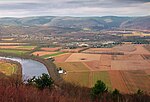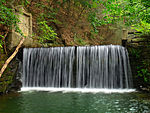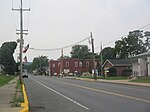McElhattan, Pennsylvania

McElhattan is a census-designated place (CDP) in Wayne Township in southern Clinton County, Pennsylvania, United States. As of the 2010 census, the population was 598.The community is located in eastern Clinton County and is bordered to the northwest by the West Branch of the Susquehanna River and to the southeast by U.S. Route 220, a four-lane freeway. The southwestern part of the CDP includes the area known as Youngdale. US 220 leads west 6 miles (10 km) to the city of Lock Haven, the Clinton County seat, and northeast 7 miles (11 km) to the borough of Jersey Shore. Bridge Road crosses the West Branch, connecting McElhattan with Dunnstable Township to the northwest.
Excerpt from the Wikipedia article McElhattan, Pennsylvania (License: CC BY-SA 3.0, Authors, Images).McElhattan, Pennsylvania
Linwood Drive, Wayne Township
Geographical coordinates (GPS) Address Nearby Places Show on map
Geographical coordinates (GPS)
| Latitude | Longitude |
|---|---|
| N 41.159722222222 ° | E -77.361388888889 ° |
Address
Linwood Drive 8
17745 Wayne Township
Pennsylvania, United States
Open on Google Maps










